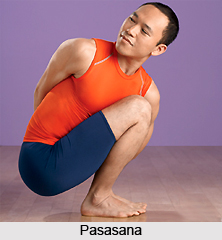 Pasasana is a cultural asana that is therapeutic for a host of illnesses, including asthma, back pains, neck tensions and indigestion. It derives its name from pasa, meaning snare or trap in Sanskrit.
Pasasana is a cultural asana that is therapeutic for a host of illnesses, including asthma, back pains, neck tensions and indigestion. It derives its name from pasa, meaning snare or trap in Sanskrit.
Meaning of Pasasana
The literal meaning of pasa (or pasha) is snare, trap, bond or noose. The human body creates a noose by wrapping the arms around the squatting legs with the hands clasped behind the back.
Practice of Pasasana
•Stand in erect mountain posture (Tadasana) next to a wall with the feet hip-width and parallel to each other. Ideally, one should stand a forearm`s distance from the wall.
•Standing in Tadasana with the wall on the right side, turn to the right and press the right palm into the wall-from wrist to elbow, the forearm should be parallel to the ground.
•Adjust the distance to the wall accordingly and turn the torso back to center.
•Bend the knees into a full squat, with the buttocks sitting on the heels. If unable to get the heels fully on the floor, squat with the heels raised on a thickly folded blanket or sandbag.
•Swing the knees slightly to the left.
•While exhaling, turn the torso to the right and press both hands into the wall. As the left hand presses into the wall, the elbow should press against the outside of the right knee.
•Support the pose by using the right hand for leverage-the right hand will be high and the left hand will be low. For the full pose, it is necessary to close any space between the left side of the torso and the tops of the thighs. So work the back of the left arm down the leg, moving the back of the left shoulder toward the outside of the right knee.
•Press the knee and arm (or shoulder) firmly against each other. Use this pressure to lengthen the left side of the torso out of the inner groins, sliding it along the tops of the thighs. There is a tendency in these deep twists to harden the belly, so try to keep the belly soft.
•Keep the right hand on the wall or bring the palms together with the elbows angled sharply away from each other. Use the pressure of the palms to increase the twist.
•Stay in this pose for 30 seconds to a minute. Release the twist with an exhalation, then repeat for the same length of time to the left.
•Perform the first seven steps as described above.
•Then snug the knee into the armpit, bend the elbow, and swing the forearm around the front of the shins.
• Position the hand just to the outside of the same-side shin. Then exhale and sweep the other arm behind the back.
•Grasp the top hand (or wrist) with the bottom hand.
•To increase the twist, use the bottom arm (the one wrapped around the legs) to pull down on the top arm.
Anatomical Focus of this asana is on the arches, thighs, knees, ankles, abdomen, hips, chest, shoulders, spine, intestines, kidneys, liver, Bladder and uterus.
Effects of Pasasana
•Stretching of the ankles result in more strength and flexibility.
•Stretches the thighs, groins, and spine. Functional strength is much improved.
•Opens the chest and shoulders
•Stimulates the abdominal organs
•Improves digestion and elimination
•Improves posture
Precautions in the practice of Pasasana
Do not attempt the asana when undergoing lower-back injury and Hernia
Also avoid deep squats with any knee injury



